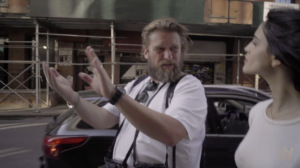
Screen shot of photographer Greg Williams at work.
There are online classes or sessions of all kinds these days, such as The Great Courses (“Learn at your own pace with no schedule, while exercising, commuting, or just relaxing. Just you and the world’s greatest professors!”); TED Talks (“free knowledge from the world’s most inspired thinkers”); and the ones in this list of business (and some academic) classes “that’ll boost your skills and get you ahead.”
MasterClass, which has its own streaming platform with “video lessons taught by 100+ of the world’s best…in business and leadership, photography, cooking, writing, acting, music, sports and more,” looked somewhat interesting but stopped selling monthly access in favor of an annual membership fee, which was more than I would spend.
I have watched free material from these sorts of classes, here and there, especially during the pandemic, but had never paid for a course because the pacing always felt slow and the material thin. Besides, if I am not working or with my family I would usually rather spend the time reading.
(Schopenhauer disagrees with that too: “The thoughts of another that we have read are crumbs from another’s table, the cast-off clothes of an unfamiliar guest.”)
But before Christmas I saw a photography class I wanted to try, and one of my sons bought access to it for me as a gift. I enjoyed it and can imagine the experience might be as rewarding at other sites.
This one, at Skillsfaster.com, was an online photography “course” by Greg Williams, a well-known film-set and fashion/art photographer. (He shot the poster poses of Daniel Craig for films such as Casino Royale, eg.) The course is eight skills videos (Exposure, Focus, Editing, etc.), each with a “homework” assignment; “practical” videos (showing how he shot Tom Hardy or Matt Smith); and a bunch of “photo breakdown” videos that go over the choices he made in specific shots he likes.
Videos can be less than two minutes or up to 17 minutes in length. In total, there is about an hour of instruction. The cost—about $40 on sale—was worth it, for an amateur like me, who would like to get a little better.
Williams says he does not strive for technical perfection in his own work, so he believes what he has to say about his own process will translate to viewers’ photography. He says his photos are meant to look “candid,” which he says means, “Honest, it means spontaneous, it means alive, it’s unscripted, it’s imperfect….”
He often shoots with professional cameras but does use an iPhone 12 Pro Max, about $1,100 before trade-in, for some of the tutorials.
“Ultimately what I’m trying to help you get is a great photo of a person within [an] environment,” he says.
I will not reveal his instruction, but it includes tips for interacting with subjects, which might mean being emotionally present, to get others to respond “into the lens,” or, on the other hand, “becom[ing] very small and humble.” Williams also believes in being able to walk into any space and to find photos, and that “There is no bad light,” all of which feels liberating (at least until I try to put that advice to use).
Your story, he says, is “your unique perspective on the world.” That seems like a fair explanation of why we seek instruction.
